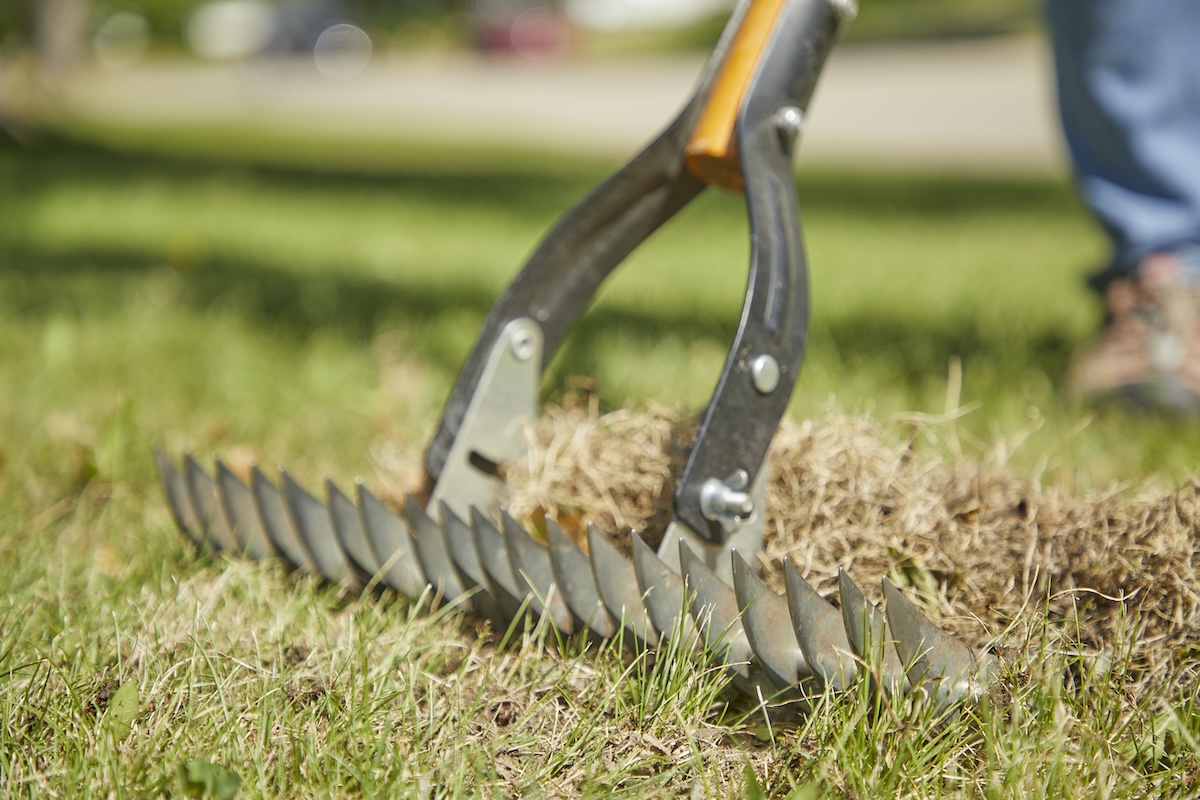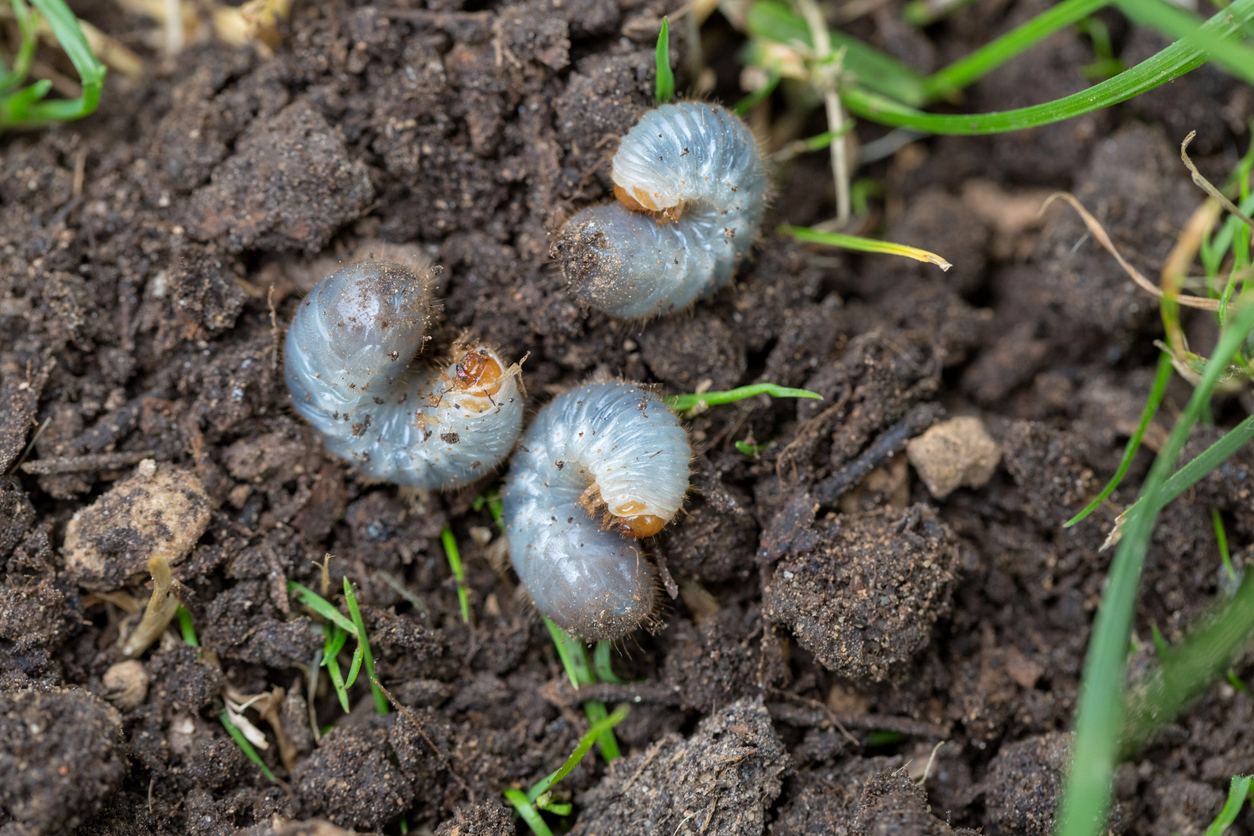

We may earn revenue from the products available on this page and participate in affiliate programs. Learn More ›
Of all the plants, trees, and shrubs in your landscape, the lawn is the most demanding feature, requiring constant maintenance throughout the growing season to look its best. So when, despite your best efforts, it doesn’t look up to snuff you need to look a little deeper—literally.
Thatch, which comprises living and dead material, accumulates naturally at the base of grass where the blades meet the soil. Mulched leaves and short grass clippings tend to decompose quickly. Thatching occurs when the buildup of these materials outpaces decomposition and the thatch layer thickens. The thicker the layer, the more difficult it becomes for water, nutrients, and air to reach grass roots. When this happens, the lawn suffers and it’s time to dethatch.
1. If you think your lawn might need dethatching, look for these telltale signs of distress.

Thin blades, weak growth, and pale color are telltale signs that your grass is struggling. To confirm whether thatch is the culprit, you’ll have to do some digging. Use a sharp trowel or spade to dig up a small section of grass.
You’ll likely see a layer of brown matter where the soil meets the base of the grass blades. That’s thatch, and it’s totally normal. But if the thatch layer is more than an inch thick, it’s preventing much-needed water and nutrients from reaching the roots.
Also, lawns with a thick thatch layer might feel spongy underfoot or be difficult to penetrate with your finger as you try to reach the soil surface.
2. Dethatching a lawn only needs to be done every two to three years.
Unlike mowing, lawn dethatching is not a frequent lawn chore. Instead, it’s something you might do every two to three years, depending on the type of grass and your growing conditions.
Some fast-growing grasses like fescues and Kentucky bluegrass are more prone to thatch than other varieties, especially when grown in compacted or heavy clay soil. Timing should coincide with your lawn’s peak growth period and varies based on the type of grass you have.
3. Determine which dethatching tools will work best on your property.
The best dethatching tool for the job depends on the size of your landscape and how much work you’re up for. Manual thatching rakes are available at most lawn and garden stores; they’re popular for smaller lawns, light thatch, and general thatch maintenance through the growing season.
Power rakes are a go-to for larger areas of thinner thatch layers with grass that can withstand intense raking, for homeowners with big yards or persistant thatch issues. Before using a power rake, however, it’s important to understand their formidable capabilities!
“Power rakes are designed for heavy-duty thatch removal, equipped with rotating blades that aggressively cut through and remove dense layers of thatch,” says Gene Caballero, co-founder of GreenPal, a Tennessee-based lawn care company.
This means their aggressive approach to dethatching a lawn can disrupt the surrounding soil and damage nearby vegetation if not handled properly. Bottom line: Use them with caution!
Vertical mowers are the heavy-hitters that work best for thick thatch layers, and considering how infrequently they’re used, these machines are often better rented rather than purchased. Here is how to use each type of dethatching tool:
- Thatching rake: By using the same motion you would to rake leaves, the short tines and curved blades of a dethatching rake (such as TRG’s Groundskeeper II) can dig into your lawn to pull up the thatch layer. Our researched guide to the best dethatching rakes has a variety of excellent options.
- Power rakes: The electric version of a dethatching rake (such as this Greenworks’ 10-amp corded dethatcher) is pushed much like a lawn mower. Instead of blades, a power rake has rotating tines that dig into thatch and lift it out as you push.
- Vertical mower: Lawns with thick thatch or those in need of total renovation would benefit from this aggressive approach. Vertical blades on a mower or scarifier (this model from Sun Joe is one to consider) penetrate the thatch layer and the soil. It’ll lift the thatch—and plenty of grass roots—out.
“Never use a power rake or a dethatcher on warm-season grasses like Saint Augustine or Bermuda. They’re just too harsh for these types [of grass].”
—Bryan Clayton, CEO of Tennessee-based lawn company GreenPal
4. There’s a difference between a lawn dethatcher vs. aerator, and a right time to use each.
It’s easy to confuse lawn dethatching and lawn aerating. Both tasks improve the state of your grass by giving roots the nutrients they need to grow better.
A dethatcher removes layers of natural debris between the soil and base of the grass with a raking tool. This process is required when the thatch layer is more than ½ inch thick.
- Dethatching removes the barrier that blocks air, water, fertilizer, and other nutrients from reaching the grass roots.
- Aerating is a process of poking holes into the lawn and pulling out plugs of soil and turf (which are left to decompose on the lawn). The holes create small waterways for nutrients to get deeper into the soil.
This activity needs to be done when foot traffic, mowing, watering, and other activities cause the soil to compact, obstructing nutrients from reaching the grass roots.
5. Only dethatch a lawn when it’s healthy.

Dethatching is stressful, so doing it when your lawn is at its strongest during the year will aid its recovery.
“Avoid dethatching when your lawn is stressed, during extreme heat, or when it’s actively growing seedlings. Disturbing it during these times can cause more harm than good,” Clayton advises.
Early spring and early fall are ideal times for cool-season grasses like Kentucky bluegrass and perennial ryegrass.
Your cue to dethatch warm-season varieties like zoysia and Bermuda grass occurs in spring or early summer after they’ve completely “greened up.”
If your lawn is dormant or stressed by drought, don’t dethatch. You can do irreparable damage.

Tried-and-True Advice
“Don’t attempt to dethatch a lawn too early in the season, especially when the grass or soil beneath it is wet. I live in Minnesota where we get snow well into the spring, so grass can appear dead and dry in May but the soil beneath is soaked. Attempting to dethatch a wet lawn will damage the grass. Wait until you start to see green growth across most of the lawn.”
—Amber Guetebier, Contributing Writer
6. Your lawn will grow stronger without a thatch barrier.

Allowed to grow unchecked, thatch forms an impenetrable barrier that prevents water, air, and nutrients from reaching roots.
A thatch layer of an inch or more is a breeding ground for fungal diseases and mosquitoes that favor humid, wet conditions where water can’t percolate into the soil.
What’s more, grass roots become snarled in thick thatch instead of knitting into the soil, making them vulnerable to damage in prolonged periods of hot, dry weather.
Dethatching, while necessary and beneficial to the lawn, often can leave the lawn looking anything but lush.
With the new real estate available, grass roots will spread and fill in the bare spots. It’s also a great time to spread grass seed.
7. Learning how to dethatch your lawn is easy, but actually doing it is hard work.

For small lawns, use a dethatching rake to work across the lawn using the same motion you would when raking leaves. Not only will you be helping your lawn, you’ll get a workout too.
Power rakes, available for rent at many home improvement and hardware stores, are ideal for larger spaces and operate like a lawn mower.
As you push it back and forth across the lawn, the rake lifts thatch and deposits it on top of the grass. Both methods leave a significant amount of debris behind.
At this point, you have a few options for how to dispose of the yard debris:
- Bag it as yard waste for your next garbage pickup.
- Call your municipality to see if they have a composting program.
- Compost it for your garden. Avoid this option if your lawn is chemically treated or full of weeds at the time of dethatching.
8. If your lawn is in poor condition, consider hiring a professional dethatching service.
There are times when having a professional lawn dethatching service come to your home is the best option for you and the health of your grass.
For big thatch removal jobs, thick patches of thatch, or if you simply don’t have the time, a service company may be a great option.
You can usually expect to pay between $100 (for a smaller lawn) to $700 (for a large lawn) for 1 to 2 hours of work.
Professional lawn dethatching services have seasoned experts to rake and remove thatch from a yard with precision. They already have all the tools they need, saving you from having to purchase new ones.
Experts also know which tools the grass can withstand, and which ones are too aggressive, leaving the lawn in a better state than a first-time DIYer, who may mistakenly remove healthy turf in addition to thatch.
Not all dethatching services are equal. Do your research to find a reputable company that has experience removing thatch.
Ask them questions about which tools they use, and why. If their go-to is a vertical mower, even for thin patches of thatch, it’s a sign to select another company.
9. Dethatching a lawn with grubs: Should you do it?

If you’ve got a grub problem, according to Clayton, “dethatching might not be your first step,” he states. “Treat the grub issue first, as dethatching a grub-infested lawn could open it up to more damage. Once the grubs are under control, then consider dethatching to help the lawn recover.”
This means timing is crucial. Address the problem when grubs are most active near the surface (early fall or spring). A few effective methods for ridding your lawn of grubs:
- Introduce beneficial nematodes that naturally prey on grubs
- Maintain proper watering
- Apply neem oil to prevent grubs from feeding
“Once the grubs are under control, then consider dethatching to help the lawn recover,” Clayton says. “Remember, the goal is a healthy, thriving lawn, not just a good-looking one. It’s about creating an environment where grass can grow strong naturally.”
10. After thatching grass, aerating and fertilizing will help keep it in optimal condition.

Once you’ve cleared away the debris, you can aerate the soil directly after dethatching, if needed. Aeration is best done in spring, late summer, and even early fall. You want to aerate when the grass is primed for growth.
Use a hollow tine or core aerator to remove plugs from the ground. You want to remove cores as deeply as possible from soil that is moist but not wet, as dry soil prevents the tines from digging deeply. Once you’ve made a few passes of the lawn with the aerator, you can fertilize the lawn immediately.
Turf can be aerated every one to five years, depending on the lawn. Grass with heavy soil or lots of foot traffic will benefit from being aerated more frequently.
Is it better to dethatch or aerate? That’s a big question for many homeowners, and the answer is, it depends on your particular lawn. Dethatching is only required if your grass has thatch, but all lawns benefit from aeration.
When should you not dethatch a lawn?
Dethatching a lawn should be avoided in certain circumstances to prevent unnecessary stress on the grass.
- Dethatching is generally not recommended when the lawn is experiencing extreme heat or drought.
- Also avoid dethatching when the grass is overly wet or saturated, as this can further harm the grass roots.
Final Thoughts
Dethatching may not be an annual chore, but it’s still important to check your lawn each year for thatch. If you aren’t seeing the signs that your grass is in distress and there’s less than ½ inch of thatch, you can postpone pulling out the thatching rake.
If you’re wondering when to dethatch a lawn, really, it’s on an as-needed basis. The task should be done when grass is primed for growth, which is typically in the spring, late summer, or early fall (depending on the grass variety and climate).
Always use the appropriate tools to ensure you’re not stressing out your lawn more than is necessary, and follow up dethatching with aeration when required.
